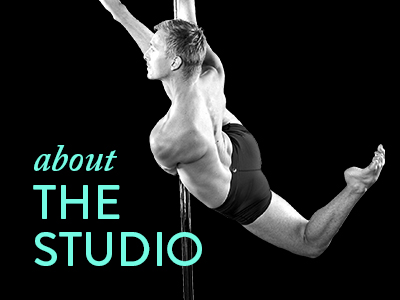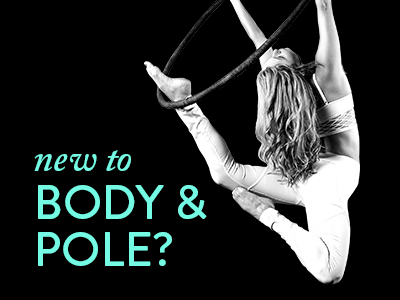We are so excited to bring you an interview with physical therapist extraordinaire Dr. Chad Woodard from SymbioPT. Dr. Chad and his team work with professional dancers and cirque performers, helping them achieve balance and longevity in their training and performance.
SymbioPT has been working with the instructors at Body & Pole in a continuing education capacity, helping us to become more knowledgeable about keeping our students safe and injury-free. We’re excited to watch this partnership grow, and will be continuing these conversations with Dr. Chad as part of an ongoing series about the body.
B&P: Dr. Chad thanks for taking the time to talk with us! Can you tell us a little more about the focus and treatment style of SymbioPT?
It is I who should send thanks for you asking to talk! You guys are the best!
Regarding our treatment style, the story is long and sordid with stories of personal injury, frustration, and determination. What has resulted is a demand for myself and my team to treat each person as an individual with a tailored set of needs, as well as treating the person instead of the diagnosis. We do not see hip pain patients or shoulder impingement patients; we see people who have non-optimal movement patterns. It’s a small difference but a huge change in how we approach each patient and design a program that is right for THEM, not the general public with a similar injury. The human body is made up of many parts, some musculoskeletal, some neurological, and some psychological and emotional. Treating just one will leave holes. Holes lead to injury.
B&P: How did YOU find your way to becoming a physical therapist?
Remember the “sordid” part from the previous question? That’s exactly how I became a PT!
Back in biblical times, I was a dancer and performer. In a word, I felt more joy doing that than anything else on this earth. But as is so common with dancers and performers, I started developing a nasty case of hip pain. It got to the point that after a dance class, I was unable to walk or get out of my car.
I figured I better get it checked out or my dancing career was done, so that’s what I did. To make a long story short, I saw orthopedists, neurologists, rheumatologist, and Lord knows how many others. None of them found anything wrong with my hip. None of them had a solution. In a moment of frustration they finally sent me to one more medical professional: a psychiatrist. The medical system had failed so badly in my case that they resigned themselves to saying I had a psychological disorder causing my pain, and therefore needed to be medicated. Now don’t get me wrong, I am many shades of crazy and own that whole-heartedly. But in this case, medicine changing my serotonin uptake had the expected effect on my hip: absolutely nothing! I was left feeling unsure, and frankly, completely terrified about my body. I stopped dancing out of necessity. Part of me died with that decision, and I lament that to this day. I became a PT to fix my own hip, and that I did (boom!). The only annoying part: it was a very easy fix. e and my “detrimentally pathological hip” have completed 6 Ironman triathlons since. I guess I didn’t need those meds after all…
B&P: Ha! What a great success story! So, what are some of the best ways to prevent injury when we are training so intensively and singularly in a particular apparatus?
The answer is both complex and simple: balance. No, not standing on one leg, but maintaining balance throughout the body. Intense training of a single modality or sport will often lead to imbalances in the body.
Think of your body as a massive system of kids in gym class playing tug-of-war. One group of kids will win, the other will lose. Who is going to cry? The losing team. Same happens in the body. If a sport is inherently biased to making one set of muscles and structures stronger than another, the weaker/inhibited side will lose and then “cry.” The reason the answer is complex is because every person will develop their own personalized way to excel at a specific apparatus. This means that their group of “winning kids” is different than someone else’s. That also means their “losing kids” are different and must be treated as such. Helping athletes find their balance is what my team and I do for a living.
B&P: What are some of the most common injuries or imbalances you see amongst aerialists and pole dancers?
Aerialists and pole dancers ask a pretty tremendous amount from their shoulder girdle complex. What you guys can do with your shoulders is highly demanding, highly specific, and highly freakin’ hard.
The shoulder girdle is terrifically complex, more so than we can cover here adequately. But with 4 major joints and roughly 40 muscles directly affecting the movement patterns of the shoulder, it is highly susceptible to getting tweaked.
B&P: Ok, so let’s talk about when injuries happen. What are some of the indicators of a more lasting problem, or how long should we wait before getting a professional evaluation?
You might be asking someone with a strong bias about this, but a vast majority of my patients say the following sentence: “I knew it was bothering me but I thought if I just rested it and ignored it for a while it would go away.”
My follow up is usually something like, “..and how has that gone for you?” Then we hug it out and get to work.
But honestly, intense exercise like what B&P instructors and students do will also come hand in hand with some intense reactions in the body. Some of those reactions will indeed be painful. I have humiliated myself at your studio by taking an Intro to Pole class, and as God as my witness, I had some PAIN. (mostly in my face from all of the smiling…)
General rules though:
-if it is swollen/red/hot, get off of it!
-if it hurts for more than a few hours, make note. If it hurts for more than a day or two, you over did it, and could be time to think about bringing in backup.
-if your muscles are sore, congratulations at getting stronger. Just give yourself the nutrition and rest you need to heal and integrate that strength.
B&P: What are some of the risks of letting an injury continue untreated?
How scary would you like me to go here? Injuries that go untreated are the quickest way for Dr. Chad (and the orthopedic surgeons of the city) to buy a vacation home… While it does sound lovely, please stop funding this account!
B&P: So, it sounds like listening to your body is pretty important. If I am injured, should I still take class? What about stretching, is that safe even if I’m injured?
I swear I am not being bribed into saying this, but the instructors at B&P are some of the most knowledgable and reliable that I’ve ever met. If your instructor tells you to avoid class, do it. If your instructor tells you to modify, do it. If your instructor tells you to see a devilishly handsome PT, do it twice.
Some injuries get better with stretching and some get worse. If you’re unsure, please ask someone who knows. And no, that absolutely does not include Dr. Google!
B&P: Awesome, thanks for explaining a bit about injuries! If I’m not a professional cirque performer, will I still benefit from physical therapy?
We treat everyone from pros to people learning to walk again. I for example am far from being a professional triathlete (quite far as it would happen) and I still get treated. Why? Because I am not so interested in pain and appointments with my medicine cabinet. PT keeps me moving to my best ability, and that is what I do for my patients every day. Not everyone is a pro athlete, and for that matter, relatively few people are. That said, everyone has something that doesn’t move as well as they’d like. Everyone has something that can be improved. Getting people moving to the best of their ability is our speciality.
B&P: Thanks again Dr. Chad! SymbioPT is just around the corner from Body & Pole, located on West 29th St. between 7th and 8th Aves. To book an appointment visit www.symbiopt.com. You can follow Dr. Chad on Instagram – @askdrchad and @symbiopt



